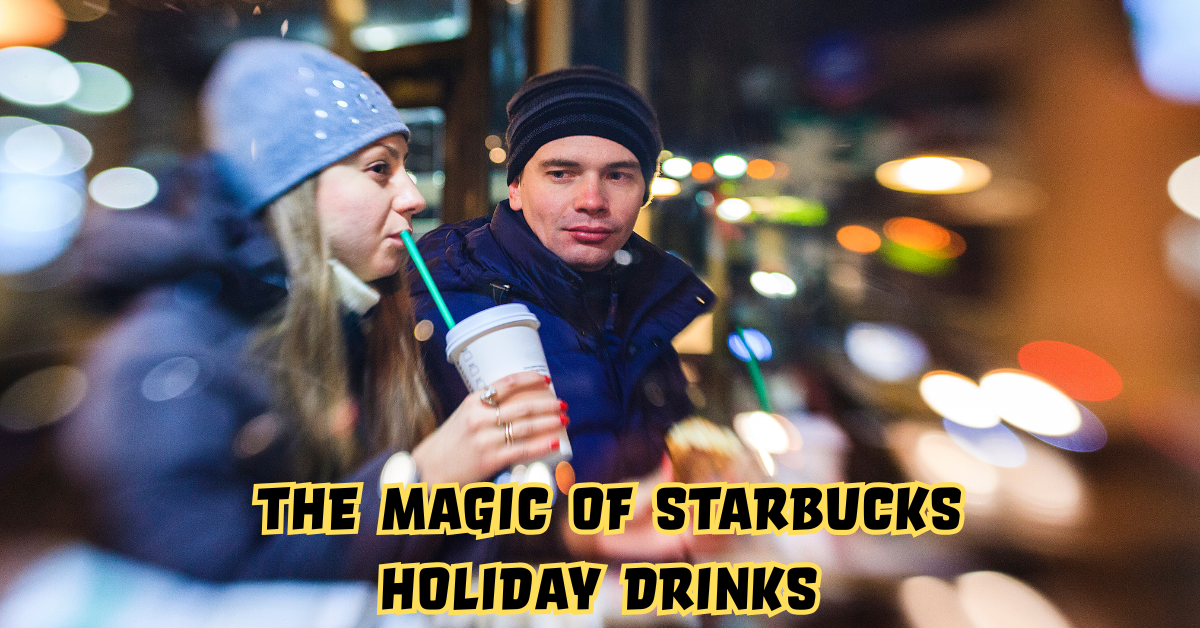From the first frost to the lingering glow of twinkling lights, Starbucks holiday drinks magnetize coffee lovers into cozy corners and brisk sidewalks alike. In the opening moments of this seasonality spectacle, the searcher’s intent is clear: one wants to know what Starbucks holiday drinks are available this year, why they enchant, how to order them, and what makes each one special. Today, Starbucks doesn’t merely sell beverages—it cultivates ritual, emotional resonance, and sensory theater. This article peels back the layers: we’ll tour the full lineup, examine the crafting process, compare their flavor architectures, and even propose pairing suggestions, while weaving into narrative why these seasonal flavors achieve cult status.
When December’s chill nips your nose, the holiday menu at Starbucks feels like a warm invitation. Sip the sugar-spiced swirl of a peppermint mocha, or taste the salt-caramel crescendo of a new wintery invention. These offerings are more than drinks—they’re markers in time, part nostalgia, part innovation. For 2025, Starbucks continues to evolve its holiday portfolio, refreshing beloved classics while daring flavor experiments. Here is everything you need: from flavor breakdowns and nutritional benchmarks to tips on customizing and savoring.
Seasonal Lineup: What’s on Starbucks Holiday Menu 2025
Starbucks holiday drinks consistently combine a mix of evergreen staples and limited-edition newcomers. Below is a table showcasing typical seasonal offerings, along with their defining flavors, launch timing, and approximate availability windows (which may vary by market):
| Drink Name | Signature Flavor Profile | Launch & Duration | Notes / Variations |
|---|---|---|---|
| Peppermint Mocha | Dark chocolate with cool peppermint and steamed milk | Early November through December | Available iced or hot; sometimes offered sugar-free syrup option |
| Caramel Brulée Latte | Rich caramel with brûléed sugar top notes | Mid-November through early January | Occasionally seasonal topping of brulée bits |
| Toasted White Chocolate Mocha | White chocolate with toasted marshmallow nuance | Mid-November through January | Offered iced, hot, or blended |
| Chestnut Praline Latte | Nutty praline, warm spices (clove, brown sugar) | Late November into December | Garnished with spiced praline crumbs |
| Gingerbread Latte / Chai | Warm gingerbread spices, vanilla, sometimes chai mix | Late November to December | Offered as classic or blended beverage |
| Winter Spice Flat White | Subtle cinnamon, allspice, brown sugar | Limited windows during holiday | Often available as hot only |
| Holiday Cookie Latte (new) | Sugar cookie, almond, hint of vanilla | December only | Seasonal limited release |
| Eggnog Latte / Eggnog Macchiato | Creamy eggnog tones over espresso | Mid-December to early January | Regional availability in some markets |
In addition to these signature drinks, Starbucks often releases companion items like holiday-themed hot chocolates, seasonal teas, and dessert pairings. Unlike permanent core beverages, the limited duration heightens anticipation and scarcity appeal.
The Alchemy Behind the Holiday Flavor Experience
What transforms a milk and espresso base into a holiday jewel is layering—both of flavors and textures. Starbucks roasts coffee blends carefully, then deconstructs and recombines them with syrups, sauces, and toppings to conjure festive senses. A Peppermint Mocha, for instance, starts with Starbucks’ signature espresso shot, steamed milk, a mocha sauce, and peppermint syrup, crowned by whipped cream and chocolate shavings or festive sprinkles. The peppermint’s cool brightness cuts through the chocolate’s richness and the milk’s creaminess, balancing structural weight.
Texture also plays a covert role: brulée sugar bits crackle on your tongue in a Caramel Brulée Latte. Crushed praline or nutty crumb topping in a Chestnut Praline Latte gives soft crunch juxtaposed to silky milk. Moreover, temperature shifts—hot versions gently melt toppings; iced versions hold them longer as you sip. Baristas in busy seasons routinely train to deliver consistent foam, syrup measurement, and attention to topping placement—for maximum visual and flavor impact.
Starbucks sources ingredients at scale, collaborating with flavor houses to refine seasonal syrups that taste identifiably festive but still integrate with espresso’s acidity and roast character. In the design lab, they may test various intensities, sweetness calibrations, or even omitting or altering milk fat levels to preserve flavor depth when ice melts. Some markets even see regionally inspired holiday beverages to match local palates and traditions.
Nutritional & Caloric Landscape: What You Should Know
Holiday drinks are indulgent by design, so being informed helps balance pleasure with moderation. Below is a sample nutritional table for medium (“Grande,” 16-ounce) sizes of popular holiday drinks, in their classic form (whole milk, whipped cream, standard syrups). Note that actual values vary by region, milk choice, and modifications.
| Beverage | Calories | Total Sugar (g) | Total Fat (g) | Notes / Tips to Lighten |
|---|---|---|---|---|
| Peppermint Mocha (hot) | ~410 kcal | ~50 g | ~18 g | Ask for “light whip” or half syrup to reduce sugar/fat |
| Caramel Brulée Latte | ~380 kcal | ~42 g | ~15 g | Use nonfat milk or almond milk substitution |
| Toasted White Chocolate Mocha | ~430 kcal | ~52 g | ~18 g | Request less sauce or syrup to reduce sweetness |
| Chestnut Praline Latte | ~390 kcal | ~46 g | ~16 g | Skip or reduce praline topping to cut sugar/fat |
| Holiday Cookie Latte | ~400 kcal | ~48 g | ~17 g | Try 2% milk and no whip cream to lighten |
It’s worth highlighting that switching whole milk to nonfat or non-dairy milks like oat, almond, or soy can reduce fat content, though sugar remains high due to syrups. You may request fewer pumps of syrup or sauce, or omit whipped cream—a common customization that can save 50–70 calories. To frame this: “control where possible” is the mantra for mindful enjoyment.
Ordering Strategies and Customizations
Starbucks holiday drinks invite personalization. These strategies can help you tailor to your tastes:
- Adjust syrup pumps: Most recipes call for 3–4 pumps of flavored syrup in a Grande. Request “half-pumps” or “less syrup” to restrain sweetness while retaining flavor.
- Swap milk types: Whole milk delivers richness, but 2%, nonfat, oat, almond, or soy can offer lighter textures or dietary accommodation.
- Skip or reduce toppings: Whipped cream, sprinkles, or praline crumbles can be omitted or used sparingly. Especially useful if you’re watching saturated fat or added sugar.
- Ask for extra espresso shots: If you want a more robust coffee flavor balancing the sweetness, adding a shot can cut through heaviness.
- Order iced vs. hot vs. blended: Some flavors translate better over ice; iced versions hold flavor integrity longer, though dilution matters. Blended (Frappuccino-style) versions offer a dessert-like move.
- “Short” or smaller sizes: In some markets, Starbucks still offers a “Short” 8-oz size—ask the barista even if not listed. This halves syrup and calories.
A friend once mused, “customization turns mass beverage into personal ritual,” and for holiday drinks that maxim holds true. Each sip can reflect your sweetness tolerance, milk preference, and mood.
Flavor Profiles Explored: What You’ll Taste & Why It Matters
Let’s take a deeper sensory dive into core holiday flavors, describing how each works in concert with espresso, milk, and texture.
Peppermint Mocha: Mint and chocolate form a classic duet. The cool peppermint resonates with winter imagery; its menthol-like sharpness slices through the dense chocolate. With espresso’s bitter edge, the pairing feels refreshing yet dessert-like. In iced versions, the mint keeps a crispness; hot versions offer comforting warmth.
Caramel Brulée Latte: Caramel’s deep toffee notes blend with the sugarized brulée topping, yielding a warm, buttery sweetness. The espresso adds browning contrast, preventing the drink from becoming syrupy. It’s dessert in a cup—especially with whipped cream and brulée bits that crackle.
Toasted White Chocolate Mocha: White chocolate emphasizes dairy fat and vanilla undertones. Toasted notes—like marshmallow, browned sugar, or graham—lend smoky dimension. Espresso’s bite is softened but still present, delivering a luscious but balanced sip.
Chestnut Praline Latte: The nuttiness of chestnut works with praline’s caramelized sugar and warm spices (clove, cinnamon, nutmeg). This drink captures the essence of winter confections: along with texture from praline crumbs, it feels festive, grounded, and spiced, without leaning too heavy on sweetness.
Holiday Cookie Latte (a newer entry): This flavor aims to evoke sugar cookie memory—vanilla, almond, a hint of buttery crust. It’s a lighter-weight dessert flavor built for contrast: not too cloying, but evocative of holiday baking aromas.
Each flavor is calibrated to evoke nostalgia, seasonality, and emotional comfort. Starbucks attempts to balance sweetness, acidity, aroma, texture, and visual appeal in a synchronized sensory package.
Market Variations & Regional Surprises
Because Starbucks spans dozens of countries, holiday offerings can differ to cater to local taste preferences and ingredient availability. Some regional variations or surprises include:
- In Asian markets, matcha or red bean flavors might appear as limited holiday options, merging festive themes with local favorites.
- In Latin America, dulce de leche or cinnamon-spiced variations might supplement the standard menu.
- In Europe, holiday menus sometimes lean lighter, favoring more spice or tea-based creations rather than heavy chocolate.
- Certain countries may offer seasonal items like a chestnut latte or spiced apple chai style beverage unique to that locale.
These localized adaptations maintain Starbucks’ global brand while acknowledging culture and palate diversity.
The Emotional and Cultural Context
Beyond compounds and calories, Starbucks holiday drinks function as cultural signposts. They evoke memory: the first peppermint mocha of December, an office party latte, the aroma of holiday baking. In a crowded café, festive cups on tables signify collective retreat from the cold. They are ritualistic markers—for many, the holiday menu’s arrival signals a psychological transition into year-end reflection.
As one barista remarked, “When someone orders their first holiday drink, I see their shoulders relax—like they’re saying, ‘I’m letting myself enjoy this season.’” These drinks are micro-celebrations. Starbucks leverages this emotional terrain: limited time, unique packaging, and social sharing all amplify the sense that this isn’t ordinary—this is holiday.
Pricing, Availability & Seasonal Timing
Starbucks typically launches its holiday menu in late October or early November. In major markets, the holiday cup and drink offerings arrive as early as the first week of November, continuing through December and sometimes into early January, depending on inventory and demand.
Pricing varies widely by country, region, and size. Premium syrups, toppings, and proprietary ingredients contribute to higher margins. While core latte base costs remain constant, holiday versions frequently come at a price premium of 10–25 percent over standard lattes.
Some Starbucks stores run out of limited ingredients late in the season—brulée bits, special syrups, or seasonal toppings—so occasionally certain drinks vanish earlier. This supply constraint induces urgency and social media buzz.
Starbucks also markets merchandise—holiday tumblers, mugs, collectible ornaments—alongside drinks. The synergy of drink plus branded seasonal gear amplifies the festive retail experience.
Pairing and Serving Suggestions
Holiday drinks, akin to desserts, benefit from complementary food pairings. Here are pairing ideas:
- Peppermint Mocha — paired with gingerbread cookies or biscotti offers a peppermint-spice interplay.
- Caramel Brulée Latte — go with salted caramel brownies or pecan pie bite to echo the buttery toffee profile.
- Toasted White Chocolate Mocha — complementary with vanilla shortbread or golden raisin scones enhances the toasted vanilla notes.
- Chestnut Praline Latte — pair with nutty tarts, pecan bars, or crumb cakes to echo the praline texture.
- Holiday Cookie Latte — serve alongside traditional sugar cookies, marzipan treats, or almond biscotti.
Serving in decorative mugs or seasonal glassware heightens visual appeal, and adding a sprinkle of cinnamon, nutmeg, or cocoa powder can elevate the sensory quotient for home replicators.
Home Re-creation: Can You Make Starbucks Holiday Drinks at Home?
Many fans aim to replicate Starbucks holiday drinks in their own kitchens. While exact syrup formulations are proprietary, you can approximate them with flavored syrups, sauces, and flavoring extracts. Here’s a rough framework:
- Start with a strong espresso (or high-quality coffee concentrate) and milk (dairy or non-dairy).
- Add flavored syrup(s): for peppermint mocha, mix chocolate syrup + peppermint extract or syrup; for chestnut praline, use nut syrup + spice blends + brown sugar.
- Steam milk (or heat and froth on stovetop/home frother).
- Pour espresso + syrup first, then add milk, then top with whipped cream.
- Garnish with sprinkles, cinnamon, praline crumbs, or shaved chocolate.
While home versions won’t recreate the exact Starbucks formulations, they allow you to control sweetness and ingredients. Share your experiments, tweak ratios, and over time you’ll develop a recipe that aligns with your palate.
Trends and Innovations in Holiday Beverage Design
Starbucks holiday drinks evolve over time. Observing recent trends:
- Lower-sugar formulations: In response to client demand, some syrups or sauces may be offered in “light” versions or reformulated to reduce added sugar.
- Non-dairy first design: Holiday recipes increasingly design with plant milks from the start, not as afterthought modifications.
- Textural surprises: More toppings, crackly candied bits, layering, and “float” cream layers are trending to surprise the palate.
- Limited edition mashups: Expect bold combinations—peppermint + chestnut swirl, salted caramel apple, spiced cranberry white chocolate.
- Interactive experiences: Some locations may offer customizable “flavor dash” stations during peak holiday periods where customers pick seasonal flavors to drizzle.
- Sustainability and ingredient sourcing: Starbucks highlights responsibly sourced syrups, ethical flavor houses, and packaging that celebrates holiday themes with recyclable materials.
These evolutionary threads hint at future holiday menus: more plant-based innovation, flavor cross-pollination, and means to engage customers in the experience itself.
Critiques, Constraints & Health Considerations
While Starbucks holiday drinks enchant many, they also attract critiques. The primary concern is sugar excess: with 40–50 grams of sugar per drink, they can easily surpass recommended daily intake for added sugars. Frequent consumption may contribute to metabolic stress, weight gain, or dental issues.
Another drawback: flavor fatigue. Over time, repeated exposure dulls novelty and some drinkers report that once-magical combinations feel cloying by late December. Baristas may struggle to maintain consistency in rush periods. Also, regional unavailability or early stock depletion frustrates fans.
Environmentally, whipped cream, latte sleeves, and toppings contribute extra waste. Starbucks seeks to mitigate this via reusable cups and recyclable packaging, but holiday consumption remains resource intensive.
From taste perspective, very sweet ingredients may mask the nuances of the espresso roast—less adventurous coffee drinkers might prefer simplified variants.
A thoughtful consumer can enjoy occasionally while making mindful modifications—less syrup, smaller size, skip whipped cream—to preserve pleasure with moderation.
Marketing, Social Media & the Hype Cycle
Starbucks marshals marketing muscle to generate buzz around holiday drinks. Social media teasers, holiday cup reveals, limited-time premium promotions, and influencer partnerships amplify anticipation. Once the holiday menu launches, Instagram and TikTok abound with drink reviews, close-ups of decorations, cup art, and limited edition merch. Fans love sharing moments: “first peppermint mocha of the season.”
Scarcity plays a psychological role too—the “limited time only” slogan nudges people to try early, and when ingredients run low, scarcity signals urgency and social proof. Even media outlets run stories about the holiday menu unveiling, generating free publicity.
Starbucks also sometimes conducts customer surveys or taste panels prior to launch, ensuring flavor variants are aligned with consumer trends. In many regions, they sample flavors in test stores. This is not just beverage release—it’s a seasonal brand crescendo.
Tips to Maximize Holiday Drink Enjoyment
To make the most of your Starbucks holiday experience:
- Buy early: visit in November—ingredients run out by late December.
- Use loyalty points: often Starbucks loyalty programs allow free upgrades or cheaper seasonal drinks.
- Split orders: share with a friend so you can try more flavors without overindulgence.
- Customize smartly: always ask for “less syrup” or “light whip” as a default.
- Pair wisely: combine with pastries that echo flavors, but not with sugar bombs that compete.
- Savor slowly: holiday drinks are dense; sip slowly to appreciate flavor shifts.
- Keep cup reuse in mind: bring your eco cup to minimize waste.
- Watch for flash sales or seasonal promos: Starbucks often bundles holiday drink + pastry deals mid-season.
Case Study: Peppermint Mocha — A Seasonal Icon
The Peppermint Mocha is perhaps the most iconic Starbucks holiday drink. It was reportedly introduced in the early 2000s as a seasonal variation, combining peppermint syrup with the existing mocha recipe. Over time, it became a bellwether beverage: when the peppermint mocha teaser appears, customers know the holiday menu is imminent.
Annual social media demand for the “first peppermint mocha” is strong. Starbucks sometimes uses the peppermint mocha launch as the marker for holiday season opening. In sales terms, it often ranks among the top holiday sellers worldwide. Operationally, baristas train intensively for peppermint syrup delivery, cross-contamination controls (to keep mint from affecting other flavors), and topping consistency.
This drink embodies the holiday menu’s paradox: novelty wrapped around familiar ingredients. It’s a bridge between everyday routine and seasonal indulgence. For many regular customers, it anchors their holiday beverage ritual, and its return is eagerly anticipated more than many promotional products.
Anticipating 2026 and Beyond
Looking ahead, Starbucks holiday drinks will likely continue evolving in these directions:
- Ultra-custom flavor pods: handheld flavor pods or dashes to let consumers mix on the fly.
- Shelf-ready holiday syrups: packaged to take home, echoing the holiday drink taste beyond the store.
- Lower-glycemic alternatives: sugar substitutes or natural sweeteners to reduce glycemic load.
- Augmented reality experiences: using cups or QR codes to unlock holiday content, stories, or interactive flavor games.
- More regional exclusives: localized holiday drinks reflecting indigenous flavors.
- Functional additions: e.g. spices with mild functional claims (like turmeric, adaptogens) integrated into festive beverages.
None of these undermine the core appeal: Starbucks holiday drinks will remain about comfort, communal warmth, and sensory surprise.
Frequently Asked Questions (FAQs)
1. Are Starbucks holiday drinks available year-round?
No, they are seasonal. Starbucks typically releases its holiday menu in November and withdraws it in January. Some drinks may disappear earlier due to supply constraints.
2. Can I order Starbucks holiday drinks with vegan options?
Yes. You can substitute almond, soy, oat, or coconut milk depending on location. Also ask for whipped cream omission or non-dairy whipped alternatives (if offered locally).
3. How can I reduce sugars in my holiday drink?
Ask for fewer pumps of syrup, skip whipped cream, or request light syrup. Also, choose nonfat milk or smaller sizes to lower calories and sugar.
4. Do Starbucks holiday drink recipes vary by country?
Yes. Regional menus may include localized ingredients or flavors to suit local palates, and availability of ingredients may differ.
5. Are holiday drinks healthy?
Not especially—they are indulgent treats with high sugar and calorie content. Use moderation, customize options to reduce sugars, and treat them as occasional seasonal pleasures.
Conclusion
Starbucks holiday drinks encapsulate more than just seasonal flavors—they are sensory rituals infused with emotional resonance, design rigor, and cultural momentum. From the minty sparkle of the Peppermint Mocha to the nutty warmth of the Chestnut Praline Latte or the novel charm of the Holiday Cookie Latte, each sip is orchestrated thread by thread. The company’s innovation, regional adaptation, and marketing swirl around these beverages, turning them into seasonal icons. That said, they come with nutritional trade-offs, and the savvy consumer can enjoy them mindfully—customizing syrup levels, swapping milk types, and moderating frequency. As Starbucks evolves toward lower-sugar versions, more plant-based designs, and interactive holiday experiences, the ritual will endure. Whether you’re making your own version at home or visiting your local café to claim your first peppermint mocha of the season, these drinks aren’t just about flavor—they’re about marking time, memory, and delight in a world of fleeting seasons.











